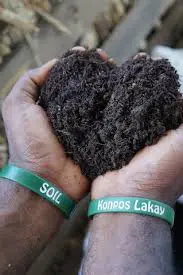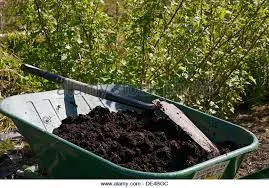How to Safely Compost Human Waste
How to Compost Human Waste

Composted Human Waste is excellent fertilizer for non-edible plants.
Disclaimer: These are my suggestions only, based on recommendations from the World Health Organization. I make no guarantees about the accuracy of this information, and whether or not it applies to your specific situation. If in doubt you should check with your local authorities.
This is an article on how to safely and easily compost human waste. It’s not difficult, but you MUST do it right, or people could get sick. The main issue is the solid waste – feces. It’s easy to deal with urine. More on urine below.
Solid human waste (feces) can be safely composted by carefully following a few simple guidelines.
First, it is much easier to compost human waste waste from a urine diverting composting toilet. The material removed from a urine diverting toilet should be just slightly damp – perfect for composting. With a non-urine diverting toilet, the contents will be too wet for efficient composting, and the combination of urine and feces creates an anaerobic environment that allows very stinky bacteria to flourish (think outhouse or portable toilet at large public event. Ugh!). A urine diverting toilet is key to the successful composting of human waste, in my opinion.

Composted Human Waste
When the human waste is removed from the toilet, you should place it in a dedicated composter. The type of container is very, very important! It must not leach out the bottom or sides, as this might contaminate groundwater. It must be protected from rain and snow – it cannot get wet. And it must have lots of ventilation.

Aerobin hot compost bin for human waste
Hot composting is a game changer.
Recently I have become a firm believer in “hot composting”. Rather than wait a year or longer for waste to compost in a typical compost bin, you can drastically speed up the process with hot composting – which is basically an insulated compost bin. I am now getting compost in about 8 weeks – sometimes even less. All visual traces of human waste and toilet paper are disappearing very quickly – often in just a few days. (This is in summer. In the winter it will be slower).
Many hot composters are pretty expensive, but I use the 55 gallon Aerobin from Costco, which is very affordable. It was a bit of work to assemble, but it is working great, and I recommend it. The 55 gallon bin is perfect for two or three people, full time. Bigger groups might consider the 111 gallon version. The Aerobin is not quite as sturdy or as well insulated as the more expensive bins, but at 1/3 of the price you can’t beat it.
You can also make a hot composting bin. Instructions are here.

Redmon Compost Tumbler
You must add other material to the compost bin, such as sawdust, leaves, grass, table scraps etc. It is a good idea to learn a bit about composting basics online. You need about a mix of “greens” and “browns”.
I just toss in some kitchen scraps (nitrogen rich) and sawdust or shavings (carbon rich) about twice a week, and mix it all up with a small gardening fork (This aerates the material and helps it break down). I add human waste as we produce it – about once a month. Dig a little hole for the human waste inside the bin, and dump it (preferably without the compostable bag which can take a long time to break down), and cover with sawdust and kitchen scraps.

Emptying the toilet is NOT gross!
Much has been written about the “correct” ratio, and no one seems to agree. I don’t think about it too much, and add roughly 50:50 greens to browns. Human waste can be considered neutral, and not a green or a brown.
Feed the beast!
If possible you should “feed” your compost bin with something once or twice a week. This keeps things going, and speeds up the composting process. At a minimum, you should definitely monitor the contents from time to time. If it seems wet (it should be just slightly damp), add dry grass, dry leaves, or some other dry carbon rich material. If it’s too dry, you’ll need to add a bit of water, and possibly more nitrogen rich material like green plants. It’s actually pretty simple and easy. Keeping the contents just slightly damp will ensure rapid and complete composting.
The beauty of the hot composting method is that you will be removing finished compost from the bottom of your container as fast as you can feed it in through the top. After the material is removed, some suggest storing it in a pile for several more months, to ensure it is fully broken down and safe for non-edible plants as fertilizer.

Compost Tumbler with large opening hatch
Additional Tips to Successfully Compost Human Waste
You might eventually need two compost bins to compost human waste, especially if you have a bigger family. In this case, use one at a time. When the first bin is full, start using the second bin. When the second bin is full, the first one should be ready for the plants.
There are bins with two chambers. This is intriguing, but I have not tested them. I don’t know if the capacity of each side would be sufficient.
Adding lime to the compost after it has been removed from the bin will drastically reduce the time it has to sit, before being safe to bury or spread on non-edible plants. Use roughly 3% lime to total compost volume.
Note: Lime may reduce the quality of the compost, depending on how you plan to use it.
You must never put composted human waste on edible plants, because of the small chance that dangerous bacteria are still present. Always use human waste compost on non-edible plants only, or bury it.
Pee is Easy!
It is extremely easy to deal with urine from a urine diverting toilet. You can often just drain it into a French drain, or use it as fertilizer. Some people dilute urine prior to using as fertilizer, others do not find dilution necessary.
 You can download a wonderful guide to using urine as fertilizer from the Rich Earth Institute here. They have worked with numerous universities, public health regulators, the WHO and even the EPA to establish principles for using urine from a urine diverting toilet as fertilizer. The take away message from this guide is that, at the household level, urine is not a health risk, and can be used directly on plants without treatment. Sadly, many (most?) local governments are unaware of the facts around urine, and think it is somehow dangerous. Not true. Send them the guidelines.
You can download a wonderful guide to using urine as fertilizer from the Rich Earth Institute here. They have worked with numerous universities, public health regulators, the WHO and even the EPA to establish principles for using urine from a urine diverting toilet as fertilizer. The take away message from this guide is that, at the household level, urine is not a health risk, and can be used directly on plants without treatment. Sadly, many (most?) local governments are unaware of the facts around urine, and think it is somehow dangerous. Not true. Send them the guidelines.
If you follow these simple steps, you will have a complete, safe, odor free and low cost waste treatment facility on your property. Unlike conventional sewage or septic systems, you will completing the circle of nutrients, returning much of what you consumed back to the earth. You won’t be creating toxic sludge to be burned in a high temperature furnace, or treated in a typical sewage treatment plant using vast amounts of energy and producing considerable CO2.